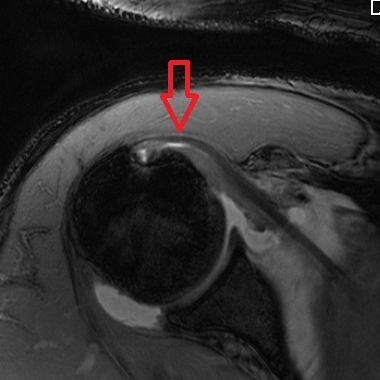A Torn Rotator Cuff--Treatments and Prognosis
An MRI can be helpful in showing the torn y.rotator cuff injury.
A common, and certainly painful injury which requires physical therapy is a torn rotator cuff. Whether it’s the result of an injury or an accident, a torn rotator cuff may or may not need surgery. While surgery is sometimes not required, physical therapy is needed as the muscles in the upper arm and shoulder can quickly atrophy and range of motion is compromised. Here we explain some things which may be a part of a torn rotator cuff injury:
Tests
Testing such as an MRI or ultrasound can give a better picture of how extensive the damage is before proceeding with a plan of treatment. Sometimes x-rays are used, for example, if the doctor suspects bone spurs.
Surgery
There are several potential surgeries available in the event surgery is required. The first is traditional surgery. While this may seem counterintuitive, since there are so many less invasive procedures, sometimes a surgeon will opt for traditional surgery because this option provides the ability to get the ‘best’ repair for some types of damage. Other options are arthroscopic repair, which involves a tiny camera and is minimally invasive, or the option between these two surgeries, which is a mini-open repair.
Non-surgical healing
In some cases, surgery may not be necessary as a rotator cuff tear can heal on its own. In other cases, the surgeon may want to wait and see if that happens, since torn rotator cuff injuries can be complicated.
Pain control
Several types of pain control are used when dealing with a rotator cuff injury. Oral pain killers and ice packs are the most common, followed by judicious use of corticosteroid injections when indicated. While these injections can relieve pain, they come with pros and cons which should be weighed carefully before proceeding.
Physical therapy or occupational therapy
As the injury heals, physical therapy will begin. Pendulum, passive range of motion exercises and active-assisted exercises are extremely effective in preventing and correcting atrophy and restoring the range of motion following a surgical or non-surgical repair and healing. An occupational therapist will also take into account the occupation of the patient and tailor the treatment to meet the demands of the patient's job responsibilities.
Home exercises
The diligent patient truly has a phenomenal impact on continued healing of a rotator cuff injury. Between or after physical therapy appointments, the patient is given a set of exercises to do at home. Regularly practicing these exercises will help fine-tune the muscles in the arm and shoulder back to their pre-injury strength and range of motion.
Future prevention
Regular well-chosen exercises following recovery after a torn rotator cuff can reduce the chance of re-injury.
By continuing with exercises, including some well-chosen strength-building exercises, will help the patient be able to reassume some pre-injury activities.
As the strength in the shoulder builds, so does the chance of re-injury in the future. A complete recovery is desirable and often the outcome.
If you are looking for occupational or physical therapy, vestibular rehab, wheelchair training, learning to walk, unweighting, or other services in the Phoenix area, please call Touchstone Rehabilitation at 602-277-1073


